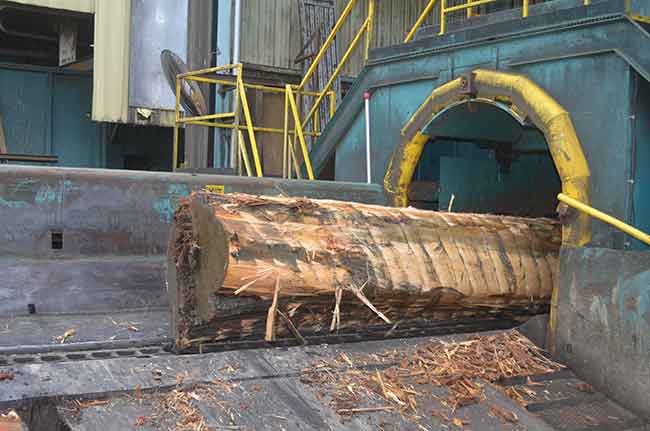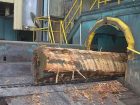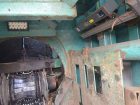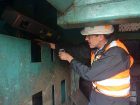
New Gear
Equipment
Sawmilling
Optimizing log scaling
Aug. 16, 2016 - Interfor’s Acorn sawmill in Delta, B.C., has entered uncharted territory for North American mills, becoming the first sawmill on the continent to have a scanner installed that is approved to automatically measure log volume for trade.
August 11, 2016 By Andrew Snook
 Photo: Annex Business Media. Interfor’s Acorn sawmill in Delta
Photo: Annex Business Media. Interfor’s Acorn sawmill in DeltaThe scanner, the Springer-Microtec Logeye, has been tested and certified by Measurement Canada to meet the recently released Terms and Conditions for the Approval of Timber Dimension Measuring Devices. (While similar scanners were already being used for optimizing log breakdown in sawmills across Canada, the Logeye is the first scanner to meet the specific requirements for certification.) Before implementing the scanning technology for log scaling, the mill needed to manually scale 100 per cent of its logs off site at a dry land sort facility. In 2016, Acorn will scanner scale approximately eight per cent of its consumption and pay stumpage based on the data. In 2017, Acorn anticipates that the percentage will increase significantly.
“We wanted to weigh pre-sorted log booms we were putting in the water,” explains Bruce Moran, timber value supervisor for Interfor’s Campbell River operation who oversaw the pilot project at the Acorn mill. It was shortly after the approval to weigh scale logs that have been in the water that Interfor offered the Regional Forest Service a first-hand look at the new scanning operation.
How it all started
The project came to fruition years after one of Interfor’s engineers had recommended scanning instead of traditional stick scaling.
Talks with the B.C. Ministry of Forests, Lands and Natural Resource Operations about the use of scanners began in 2006, but due to the economic downturn, which was followed by a mill strike at the Queensboro mill and the mill subsequently being shutdown in 2008, the conversation stalled. That said, the B.C. ministry thought it was a good idea and Interfor and Springer-Microtec continued to converse with the ministry about the possibility of implementing this kind of technology into a sawmill on a pilot project basis.
“A great deal of planning and teamwork was required before the first boom of logs went through the scanner,” explains Peter Dyson, a researcher in the Forest Operations Division of FPInnovations that assisted with the testing of the scanner at the Acorn sawmill. “It has taken work from various committees, including the CSA Technical Committee on Scaling Roundwood, which put together a standard for scanner scaling; a provincial scanner scaling committee; and a federal component because Measurement Canada has to certify the scanner. All parties worked together to come up with regulations and a standard that would meet individual provincial scaling regulations that every province could adopt to meet its needs.”
The persistence and hard work of all the participating parties paid off, leading to the scanner being certified by Measurement Canada (MC) at its Ottawa laboratory in September 2015 and subsequently being installed at Interfor’s Acorn sawmill in October 2015. The B.C. government then authorized a scanner pilot project at the Acorn Sawmill in February 2016.
“Interfor is really at the forefront for pushing something new forward,” says Norvin Laudon, chief technology officer for Springer Microtec. “They had to take significant risks and are sharing the results with industry. This wouldn’t have happened without this sort of company.”
Springer-Microtec currently has over 100 scaling scanners in use around the world, certified through various governmental bodies.
“The work done by the various members of the CSA committee, in particular Measurement Canada, has ended up with Canada having one of the most thorough scanner certification programs in place worldwide,” Laudon says.
To date, the Acorn mill has experienced an estimated savings of $8 per cubic metre stemming from reduced log handling on the volume that meets the requirements of the scanner pilot program. By implementing the scanner scaling, logs no longer need to be dewatered, stick scaled, re-bundled and re-boomed. The logs go directly from the harvest site to the mill where they are scanner scaled.
“If we can’t measure a log we’ll bring a guy in with a scale stick and have him measure it, but we haven’t had to do that once yet,” Moran says. “I’m proud of the result we’ve got so far and the amount of data we’ve gotten out of it.”
The potential savings from implementing this type of technology has already grabbed the attention of other coastal mills, as well as mills in Quebec and the B.C. Interior.
How it works
The logs are harvested, processed and sorted to mill specifications. They are then hauled to a log dump at tidewater where they are put in bundles. The bundles are then put in booms and are towed to the marine storage area and then to the Acorn sawmill.
“At the mill, the bundles are broken down and logs are placed on the log deck,” Dyson explains. “The logs are debarked, scanned, and then enter the mill inventory after scanning. All logs are linked to the harvest site by a timbermark. To ensure the scaled volume is linked to the harvest site, the pilot project regulations require all logs in a boom have the same timbermark. Interfor developed procedures for ensuring the scaled volume of one boom is kept separate from the next boom.”
The scanner does not measure top and butt diameter at the actual log ends because log ends often have splits or other damage, and the butt end can be irregularly shaped or flared.
Instead, the scanner measures the top diameter at 20 cm from the small end and measures butt diameter at length midpoint. The log taper is calculated from diameters measured every 10 cm along the log.
“The scanner only measures volume – species and grades are determined by piece scaling sample bundles at the sort yard,” Dyson says. “Sample bundle species and grade volume ratio is applied to the scanner volume.”
To ensure accuracy of the scanner, a manufactured pole or “test log” is run through the scanner at the Acorn mill. The accuracy is then verified and the test log measurements are recorded in a logbook.
In addition to scanning the volume, the data collected is also used for bucking optimization.
All measurements are compiled and sent to the province’s Harvest Billing System for payment.
In addition to lowering manpower and log handling costs, the Springer-Microtec Logeye scanner reduces scaling costs, provides more accurate log measurements for trade than traditional methods and allows the user to better forecast their log costs.
“The real benefit of applications like this will be realized once the coastal forest industry embraces the new technology and there are more systems in place at various sawmills on the coast,” Moran says.
Print this page


